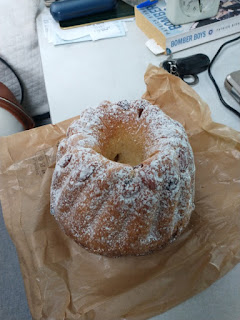It rained for a good part of the night and the prospects for
the planned drive through the mountains did not look encouraging. Fortunately,
I had found a silver mine that we could visit and this was to be our first stop
on the drive.
We set off north over the Col Haut de Ribeauvillé to Sainte Marie aux Mines, the hint
being in the name – it is in a mining area! Just a few kilometres south-west of
the town is the silver mine of Tellure. We arrived at the mine just after noon
and decided to have an early lunch in the van before going in.
We started the visit with a 10 minute film in French and then went through to
the museum where an English language audio guide told us about the exhibits. We
had been told that the guided tour of the mine would be in French and English
for the six people in our group. However, when Adrian collected us from the
museum, he explained that the other four people (three Germans and one French)
were happy to have the explanations in English. We were very grateful (as was
Adrian) because we would get more detailed explanations. Adrian was very good –
enthusiastic, knowledgeable and willing to answer any questions – and the fact
that we were such a small group meant that he was able to point out things that
he couldn’t with large groups. The mining started in the 16th
century and the miners were paid for the progress of their tunnelling rather
than a share in the minerals extracted. This was just as well as they often
only progressed 4 cm in a day and it could take years before they found the
vein of ore. Even when they found the vein, it contained only a small amount of
the copper/silver ore and only 4% of that was silver. In the 16th
century being a silver miner was considered to be a very good job. The mining
was relatively safe as there were no dangerous gases and, as the rock was very
stable, the risk of tunnel collapses was very low. The miners only worked an
eight-hour day, had one or two rest days a week and even had a social fund to
help injured workers and to pay for schools etc. This compared very favourably
with other workers in the 16th century who worked much longer hours
for much smaller rewards. The amount of mining in the area can be judged by the
population of Sainte Marie aux Mines – 250 people at the beginning of the 16th
Century but reaching 35,000 by the end of the century. Copper, cobalt and lead
were also mined in the area.
Our Michelin Green Guide driving route took us over the Col de Sainte Marie,
through La Croix aux Mines (yes, another mining town) and down to Fraize. We
did a supermarket shop there before driving a few more kilometres to Plainfaing
and its very pleasant aire.
Photos: A view from near to the Col Haut de Ribeauvillé during a
rare respite from the rain; A 16th Century miner pushing a ‘dog’ – a
cart used to remove the waste or ore; A partly excavated 16th
Century gallery – one miner dug out the top part of the gallery (completed) whilst
another miner followed him, digging out the bottom part (incomplete).







